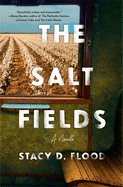
In Stacy D. Flood's gorgeous novella, Minister Peters boards a train in South Carolina in 1947, laboring under the burdens of very personal loss and the generational damage to a Black man from the South. Minister was a single father after a killing took his wife (in "the age when the murder of a black woman didn't warrant the pen, ink, or gasoline that it would take to investigate"). Now, after losing his daughter also, Minister departs for the promise of the North and an escape from his ghosts.
The Salt Fields puts Minister at a crossroad, with little left to breathe life into him and nothing to lose. He's seated on a train with three strangers, and the dynamic flows from there. Flood packs generations into a novella not much more than 100 pages long, with language cradling the horrific thorns of the past. If prose about lynchings and whippings could ever hold beauty, Flood accomplishes it. Words are never wasted in this compact work, and Flood is proficient at painting the piece with few strokes. Sometimes this occurs on a small scale, with a line or two (e.g., the action in a club is "a long kiss between everyone in the room."), but he's equally adept regarding societal issues such as racism and sexism. In a short yet significant description, the whites-only entrance to the train station is freshly painted with Romanesque pillars, the Black entrance chipped paint over old pine. Yet both lead to a common platform where everyone awaits the same train to somewhere else. --Lauren O'Brien of Malcolm Avenue Review

